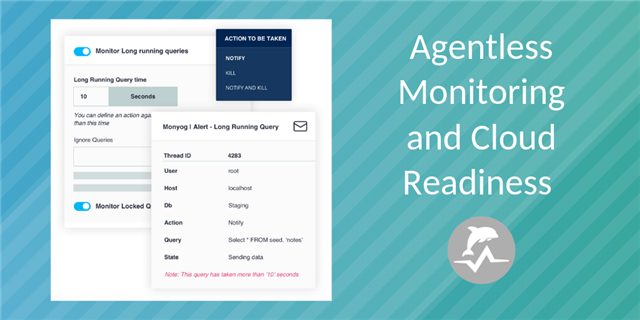Welcome back to our blog series, Benefits of SQL Diagnostic Manager for MySQL. Last week, we discussed some of the challenges associated with MySQL and MariaDB database systems. Today, we dive in to additional features of SQL Diagnostic Manager for MySQL, including agentless monitoring technology, cloud readiness, and customization options.

Agentless Monitoring
Unlike other monitoring and advisory tools for MySQL and MariaDB, SQL Diagnostic Manager for MySQL does not require installing monitoring agents on each MySQL and MariaDB server. Installing and maintaining monitoring agents can be a complex administration task by itself.
SQL Diagnostic Manager for MySQL uses a standard MySQL connection for monitoring. To collect data for the operating system from remote database servers, it uses secure shell (SSH) on Linux systems. SQL Diagnostic Manager for MySQL also supports secure shell (SSH) tunneling to connect to database servers. The connection feature means that it collects all monitoring data by using remote connections. The collection feature is a considerable advantage that sets it apart from all other monitoring and advisory tools for MySQL and MariaDB.
Cloud Readiness
SQL Diagnostic Manager for MySQL is ready for the cloud by design. It requires no agents to be installed on the MySQL and MariaDB servers. Consequently, it can monitor MySQL and MariaDB instances running in the cloud. Add and remove database servers with just a single click of a mouse button. According to our internal benchmark reports, a single instance of SQL Diagnostic Manager for MySQL can monitor more than 500 MySQL and MariaDB servers (even at collection intervals of 1 second) effortlessly. SQL Diagnostic Manager for MySQL is a perfect match for monitoring MySQL and MariaDB databases in the cloud.
Customization
Each of the included Advisor Rules enables database administrators to customize the thresholds that are acceptable for a specific MySQL and MariaDB server. For example, a database administrator using the included Advisor Rule ‘MySQL Key Cache Has Sub-Optimal Hit Ratio’ may use lower threshold values for their database servers running online transaction processing (OLTP) applications, while using higher thresholds for online analytical processing (OLAP) applications.
The entire application logic of SQL Diagnostic Manager for MySQL consists of JavaScript Objects that are parsed and executed by the embedded JavaScript Runtime of SQL Diagnostic Manager for MySQL. These JavaScript Objects are available with SQL Diagnostic Manager for MySQL as source code. The access to JavaScript Objects means that it is possible to add new monitors, modify existing monitors, and disable some of the predefined monitors that are included with SQL Diagnostic Manager for MySQL.
With no need to install monitoring agents, ability to monitor MySQL and MariaDB instances running in the cloud, and customization options for thresholds and monitors, SQL Diagnostic Manager for MySQL is the perfect addition for managing and tuning MySQL and MariaDB servers.
Read more in the full solution brief.
Find and fix MySQL performance problems on-premises and in the cloud with SQL Diagnostic Manager for MySQL.